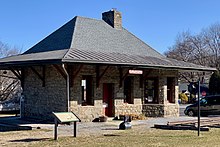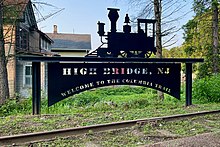
The Delaware, Lackawanna and Western Railroad, also known as the DL&W or Lackawanna Railroad, was a U.S. Class 1 railroad that connected Buffalo, New York, and Hoboken, New Jersey, and by ferry with New York City, a distance of 395 miles (636 km). The railroad was incorporated in Pennsylvania in 1853, and created primarily to provide a means of transport of anthracite coal from the Coal Region in Northeast Pennsylvania to large coal markets in New York City. The railroad gradually expanded both east and west, and eventually linked Buffalo with New York City.
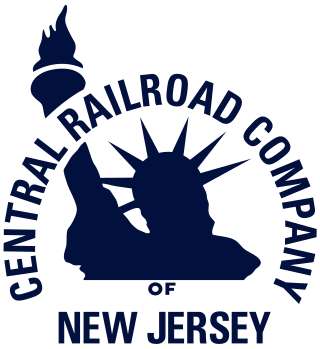
The Central Railroad of New Jersey, also known as the Jersey Central, Jersey Central Lines or New Jersey Central, was a Class I railroad with origins in the 1830s. It was absorbed into Conrail in April 1976 along with several other prominent bankrupt railroads of the Northeastern United States.

For the purposes of this article, the Jersey City area extends North to Edgewater, South to Bayonne and includes Kearny Junction and Harrison but not Newark. Many routes east of Newark are listed here.
The Dover and Rockaway Railroad was a section of railroad track completed in 1881 connecting Dover, NJ and Rockaway, New Jersey. It formed an important link in the developing U.S. railroad system, connecting major trunks to the New York harbor for freight and provided passenger service to central and southern New Jersey.

The Lehigh and Hudson River Railway (L&HR) was the smallest of the six railroads that were merged into Conrail in 1976. It was a bridge line running northeast–southwest across northwestern New Jersey, connecting the line to the Poughkeepsie Bridge at Maybrook, New York, with Easton, Pennsylvania, where it interchanged with various other companies.
The Morris and Essex Railroad was a railroad across northern New Jersey, later part of the main line of the Delaware, Lackawanna and Western Railroad.

The Warren Railroad was a railroad in Warren County, New Jersey, that served as part of the Delaware, Lackawanna and Western Railroad's mainline from 1856 to 1911.
The Belvidere-Delaware Railroad was a railroad running along the eastern shore of the Delaware River from Trenton, New Jersey north via Phillipsburg, New Jersey to Manunka Chunk, New Jersey. It became an important feeder line for the Lehigh Valley Railroad's join to the Central Railroad of New Jersey, which was constructed into Phillipsburg, New Jersey, at about the same time. This connected Philadelphia and Trenton, New Jersey at one end of the shortline railroad to the rapidly growing lower Wyoming Valley region, and via the Morris Canal or the CNJ, a slow or fast connection to New York City ferries crossing New York Harbor from Jersey City, New Jersey.

The Columbia Trail is a rail trail in rural northwestern New Jersey. It was created from portions of the former Central Railroad of New Jersey High Bridge Branch and stretches from High Bridge, in Hunterdon County, to Washington Township, in Morris County, for a total of 15.1 miles (24.3 km). The trail surface is relatively flat and consists mostly of fine crushed stone.
The New Jersey West Line Railroad was a proposed railroad running east and west across Northern New Jersey, of which the only part constructed was what is now the Gladstone Branch of New Jersey Transit between Summit and Bernardsville. Some other remains of it can be found in Summit, Millburn, and Union Township.

The Rahway Valley Railroad (RV) was a shortline railroad in the Northeastern United States. During their operations, the RV was considered as one of the most successful shortline railroads in U.S. history. The RV interchanged with the Lehigh Valley Railroad (LV) in Roselle Park, the Central Railroad of New Jersey (CNJ) in Cranford, and the Delaware, Lackawanna and Western Railroad (DL&W) in Summit.

The Ogden Mine Railroad was a mine railroad in the U.S. state of New Jersey from 1866 until 1941.
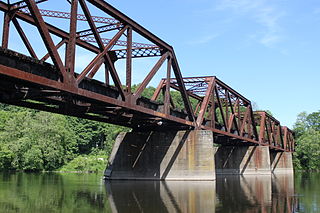
The Lackawanna Old Road was part of the original mainline of the Delaware, Lackawanna & Western Railroad (DL&W). Opened in 1856, it was, for a half-century, a part of the line connecting the states of New Jersey and Pennsylvania.
The Hibernia Mine Railroad was a mine railroad in Morris County, New Jersey that operated between Hibernia and Rockaway from 1863 to 1946.
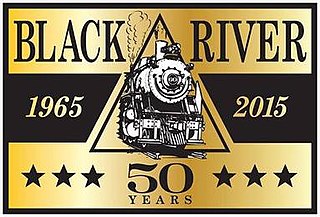
The Black River and Western Railroad is a freight and heritage railroad operating in Hunterdon County, New Jersey, between Flemington, Lambertville and Ringoes. The railroad operates vintage steam and diesel powered locomotives.

Morristown & Erie Railway is a short-line railroad based in Morristown, New Jersey, chartered in 1895 as the Whippany River Railroad. It operates freight rail service in Morris County, New Jersey and surrounding areas on the original Whippany Line between Morristown and Roseland. The M&E also operated the Maine Eastern Railroad from November 2003 to December 31, 2015, as well as the Morris County-owned Dover & Rockaway Branch, Chester Branch, and High Bridge Branches until 2017.

The Lehigh Line is a railroad line in Central New Jersey, Northeastern Pennsylvania, and the Lehigh Valley region of eastern Pennsylvania. It is owned and operated by the Norfolk Southern Railway. The line runs west from the vicinity of the Port of New York and New Jersey in Manville, New Jersey via Conrail's Lehigh Line to the southern end of Wyoming Valley's Coal Region in Lehigh Township, Pennsylvania.
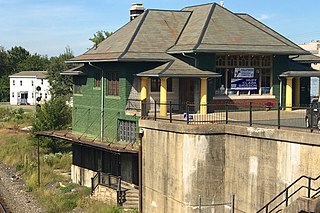
Phillipsburg Union Station is an active railroad station museum, in Phillipsburg, New Jersey, United States, at 178 South Main Street. Opened in 1914, Union Station was built by the Delaware, Lackawanna & Western Railroad (DL&W) and shared with the Central Railroad of New Jersey (CNJ) and was situated where the lines merged before the bridge crossing the Delaware River. Designed by Frank J. Nies, the architect who produced many of DL&W stations now listed state and federal registers of historic places, the 2+1⁄2 story, 3 bay brick building is unusual example of a union station and a representation of early 20th century Prairie style architecture. The Phillipsburg Union Signal Tower, or PU Tower, is nearby, also restored to its original form, and available for tours.
The Dover & Rockaway River Railroad is a short-line railroad operating in Morris County, New Jersey. On July 1, 2017, it took over operation of three Morris County owned rail lines previously operated by Morristown and Erie. The DRRV is a wholly owned subsidiary of Chesapeake and Delaware, LLC.
The Chester Branch is a rail line formerly extending from Chester Junction, near Dover, New Jersey, about ten miles southwest to the vicinity of Chester, New Jersey. Originally built to connect the iron industry at Chester with the Morris and Essex Railroad, it was always operated by the latter and became, with the rest of the Morris and Essex, a branch of the Delaware, Lackawanna and Western Railroad.


